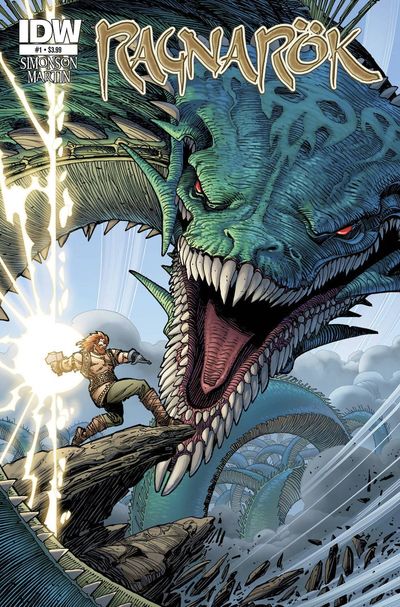There is a lot to cover on Wednesdays. We should know, as collectively, we read an insane amount of comics. Even with a large review staff, it’s hard to get to everything. With that in mind, we’re back with Wrapping Wednesday, where we look at some of the books we missed in what was another great week of comics.
Let’s get this party started.

Afterlife with Archie #6
Written by Roberto Aguire-Sacasa
Illustrated by Francesco Francavilla
Reviewed by Brian Salvatore
The first arc of “Afterlife with Archie” was one of the more pleasant surprises in my recent comics life – scary, heartbreaking, beautiful, and engaging. The arc ends with Archie and the other survivors leaving Riverdale for someplace, anyplace safe. I fully expected to crack open this issue, and see the gang on the road, “The Walking Dead” style, killing zombies and eating berries.
Instead, we got Sabrina being prepped to be the wife of Cthulhu. For real.
This issue is an interlude that follows Sabrina after being banished in issue #1 for unleashing the zombie apocalypse in an attempt to reunite Jughead and Hot Dog (which, coincidentally, she sort of did). We meet Dr. Lovecraft, a therapist at some sort of institution, and we see Sabrina try to make heads or tails of what he tells her.
This issue isn’t quite up to snuff with the rest of the series thus far – it’s just too on the nose with the Lovecraftian stuff, and not connected to the main story – but it is a bizarre, fun diversion. Francavilla’s art continues to be impressive, if overly bathed in orange, and the dream sequences, in particular, were beautifully handled.
Final Verdict: 6.0 – I’m sure this will read much better as the first story in the Vol. 2 trade, but right now, it falls a bit short.
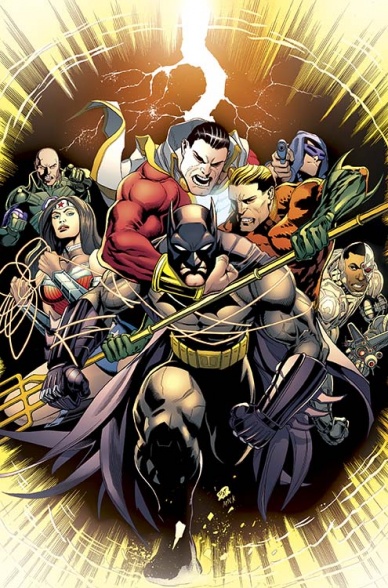
Batman And Robin #33
Written by Peter J. Tomasi
Illustrated by Patrick Gleason
Reviewed by Matt Dodge
Wow did those wheels skid to a halt right away. “Robin Rising: Omega” was pleasantly fun and exciting, and the next installment has taken all that momentum and dragged it to an angry stop. Literally this entire issue is made up of the Justice League yelling at each, then chasing Batman, then arguing some more, than Batman and Superman arguing somberly one-on-on. There are some cool moments, but they all take the form of setup for future issues.
The art is good, although the difference between Gleason and Andy Kubert’s working on “Rising” is a bit stark. Not much happens in this issue, so Gleason is forced to draw scowled face after scowled face until it gets fairly repetitive. A quick scene on Apokolips does give him the chance to show off some fun character designs, although one does have promotions that are downright Liefeldian.
Final Verdict: 5.0 – If you like your heroes constantly bickering in different locations, than this is the book for you. But there is a new Bat-suit specifically designed to punch gods in the face, which would be pretty cool if they didn’t just argue about it.
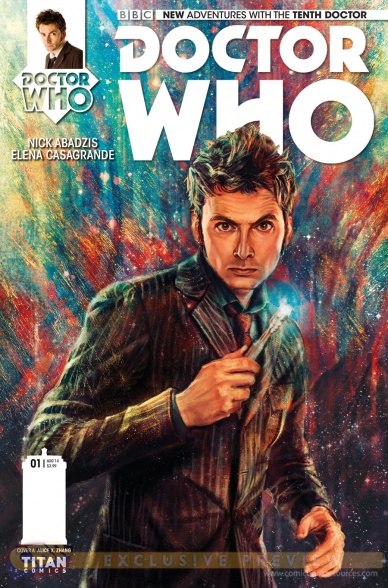
Doctor Who: The Tenth Doctor #1
Written by Nick Abadzis
Illustrated by Elena Casagrande
Reviewed by David Harper
After a very, very long time resisting it, I somehow became a very big Doctor Who fan. The series is wonderful, and arguably, the Tenth Doctor – as played by David Tennant – was the best Doctor yet, so for this week’s reviews, I jumped at the chance to review his new comic. It was helped greatly by the fact I dig Casagrande’s art, and Nick Abadzis is one of my favorite cartoonists around (read “Laika” if you never have).
This issue overall starts the series off on the right, but ultimately unspectacular, foot, only teasing the Doctor’s role really while introducing and building up the new (and American!) companion Gabriella Gonzalez. It also has to do a bit of work to put the story in the context of the Tenth Doctor’s run, and they do a nice job of subtly placing it in-between Donna’s departure and the Masterful finale. The comic’s dialogue is light and amusing, while also providing quality character work on Gabriella. While she’s still a bit of an archetype so far, Abadzis does enough to make her an inviting, engaging character who clearly is looking for something more, which is something the Doctor can offer. It’s a fun read, but one that intermittently gets lost within itself, as some scenes are murky in intent and in execution, and part of that is on Abadzis and part of that is on Casagrande. Mostly it works, but at times, I feel I’m reading a scene that would have been left on the editing room floor if it was the show.
Continued belowCasagrande’s art works very well, as her characters are expressive and cartoony without sacrificing any sense of reality, and her art engages whether you’re talking about her depicting the devil himself or the very hip Gabriella’s first meeting with the Doctor on the subway. Casagrande’s a skilled artist who has seen improvement from her work on “Suicide Risk” at Boom!, and she’s an exciting prospect who I think has a lot of potential.
This book does too, but by its nature, it’s a table setter that starts at good but never reaches great. That’s fine for now, but I’m hoping the next issue – with Gabriella and the Doctor teamed up for real, now – gets down with all that wibbly wobbly timey wimey fun we love the series for.
Final Verdict: 7.0 – a good start that could be verging on greatness

Doctor Who: The Eleventh Doctor #1
Written by Al Ewing and Rob Williams
Illustrated by Simon Fraser and Gary Caldwell
Reviewed by Zach Wilkerson
While we may have moved on from the Eleventh Doctor (quite tearfully, in my case), the endearing antic’s of Matt Smith’s portrayal of the Doctor live on in this new series from Titan. Co-writers Ewing and Williams do a great job of capturing Smith’s youthful exuberance and distinct voice, helping this issue feel a tad more authentic than usual licensed comic book fair. The issue seems to takes place during the gap between Series Five and Six, after the Pond’s wedding day. Sadly, the Ponds are nowhere to be found outside of a delightfully funny back up stip. In their place is a new companion, Alice. Alice doesn’t carry the same grand, striking import of other companions during the Moffat age. In fact, her introduction feels much more in line with a Davies companion. Still, she does have more than a few strong qualities, and her straight-lacedness plays well against Matt Smith’s manic Doctor. Artistically, the issue is spot on. While not revolutionary, Fraser and Caldwell’s loose, cartoony style fits the tone of the story perfectly. The use of coloring of coloring is particularly noteworthy. The issue opens with a funeral, and proceeds through a number of similarly unfortunate events. These pages are a drab gray, with the only color being the small blue call box the appears intermittently and inconspicuously in the background. However, much like Dorothy’s trip to Oz, Alice’s world turns technicolor at the appearance of the Doctor and an aptly name “rainbow dog.”
Overall, the issue is a fun one-off story that truly works as a sort of “lost episode.” That it shares more qualities of Davies era Who might offset ardent Eleven fans, but the magic of what makes number eleven special is not lost. Add in hints of an intriguing sub-plot about ghostly Time Lord apparitions, and you have a story that most any Doctor Who fan should check out.
Final Verdict: 8.0
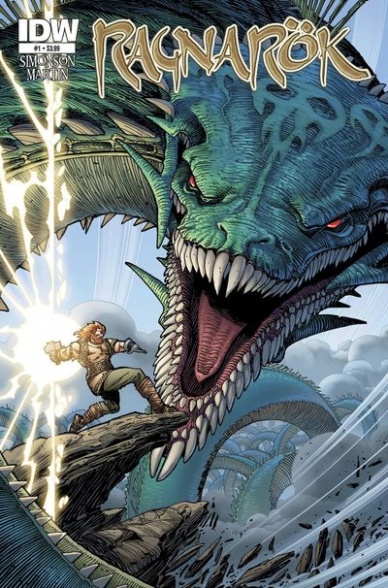
Ragnarok #1
Written by Walt Simonson
Illustrated by Walt Simonson
Reviewed by Greg Matiasevich
While Walt Simonson’s run on “The Mighty Thor” wasn’t his first big project in comics, it’s become the work he’s most known for. But he came to that title with as much or more of a lifelong interest in Norse mythology than in the Marvel Universe. So if you were wondering what he could bring to a Thor story outside The House of Ideas, the answer is: a whole lot. Every Norse-inspired story has to deal with the titular Twilight of the Gods in same fashion, so Simonson gets it out of the way in a wonderfully sepia-toned opening sequence by colorist Laura Martin, and then gets on with what happens next.
Everything Simonson does well is on display in this issue. It may deal with gods, giants, goblins, and dark elves, but they all get at least a little bit of personality and even humor (appropriately dark) under his pen. Thor may be at the center of the book’s main mystery and the one getting all the press, but the dark elf assassin mother leading this issue is one I would love to learn more about.
Continued belowAs good a read as “Ragnarok” is, the art is where this book shines. Watching Simonson work at this level is like watching Michael Jordan play basketball. He makes it look so effortless and literally awe-striking at the same time. His world is well-designed, his storytelling is dynamic and clear, and he continues to have one of the best senses of scale that comics has ever seen. Plus he has lettering partner John Workman on board, so there is total integration into getting the Simonson vision out of his head and in to the page (or screen). And we are all richer for it.
Final Verdict: 9.0 – A Simonson Norse mythology book is like a Scorsese gangster film: you can’t wait to see what a master working in his preferred playground will do.

Superman #33
Written by Geoff Johns
Illustrated by John Romita, Jr.
Reviewed by Brian Salvatore
For all that the comics internet shits all over Geoff Johns, one thing is painfully true: when motivated, that guy can write a motherfucking DC comic.
In this single issue of Superman he gives Perry White more characterization than he’s had in the entirety of the New 52. He also takes Ulysses, who could easily be the poor man’s Nuclear Man from Superman IV: The Quest For Peace, and gives him a few moments of humanity that build his character into one I want to read more from.
Even as a noted John Romita Jr. doubter, this issue shines. They got rid of the initial terrible cover seen here, and went for a far more understated look, which kicks things off in the proper tone. His Daily Planet stuff was surprisingly subtle, and the action less static than his stuff can often be.
Overall, this issue continues Johns’s attempt to take this book back to something that feels even remotely like a classic Superman story, and together with JR JR is crafting a story that feels classic and new all at once, and like a catchy song, makes you want to experience it again and again.
Final Verdict: 8.0 – Johns, along with Greg Pak on “Action,” bring the most maligned character of the New 52 into the forefront of excellence again.
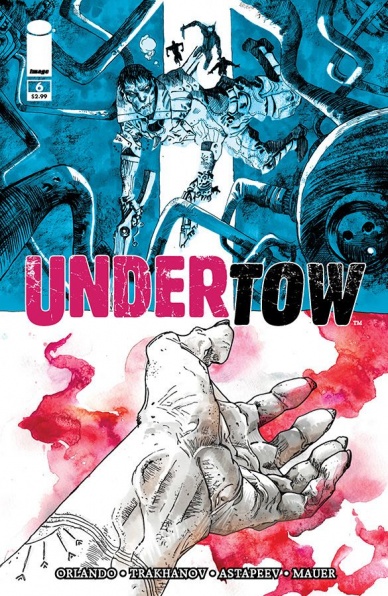
Undertow #6
Written by Steve Orlando
Illustrated by Artyom Trakhanov & Yaroslav Astapeev
Review by Vince J Ostrowski
The final issue of “Undertow” (at least for the immediate future) does exactly what you want a final issue to do in capping off a story. That’s not to say that the adventures of the Atlantean rebels couldn’t easily continue – just that the climax is as explosive and satisfying as you’d hope for and the falling action manages some tricky emotional payoff, while opening the door for an uncertain future. The last issue ended with our “heroes” in a precipitous position, but the turn-around happens quickly and impactfully. It also could easily get you to quietly cheer in your living room, if you’ve invested in the story up to this point. The emotional payoff has to do with the fate of the lead character of “Undertow” and the way he’s shaped the lives of everyone around him. A lot has happened in 6 issues, and the character growth feels authentic all the way around the cast.
Artyom Trakhanov’s inky-looking, pulpy art has gotten looser over the course of the series, to the book’s benefit. Still there is a time or three where it was difficult to discern what was going on, due to how much was packed onto a page. Most of the time, it’s easy just to chalk it up to the chaos of battle. Still, Trakhanov nicely brings home the emotional payoff that the final issue deserves, and even shares the art duties with Yaroslav Astapeev, who delivers some epilogue material that is even darker and moodier.
Astapeev adds a sinister cap on a book that felt pretty hopeful in the end. In fact, it’s the sort of thing that’ll get fans of the book hoping that it continues down the road, and with the same creative team. All in all, this was a stellar effort in world-building and epic storytelling across a mere 6 issues.
Final Verdict: 8.0 – A pretty strong finish to a unique and sprawling underwater fantasy epic.
